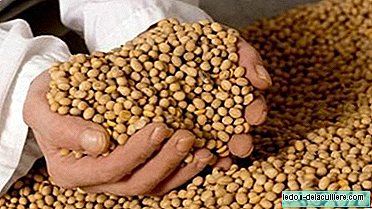
Continuing with the review we are doing to the role ofe the legumes in the infant feeding we arrive today to the soybean. It is a legume seed that has been cultivated for thousands of years in the East, especially in China, where it was considered a staple food in 3,000 BC and where it originated.
Its use has become customary as a basis for feeding cattle and for industrial uses, but it has also been introduced into our feed directly or as an ingredient in many prepared products.
Soy is an exceptional vegetable. Its protein content and the quality of these is enormous. Of every 100 grams it has 40 proteins being these almost as complete as those of meat. In addition, it has a content of about 20 grams of healthy vegetable fats, and the remaining fiber and hydrates make it a balanced, digestive and energy-rich food.
It also has vitamins A, E, F and group B (thianine, riboflavin and niacin) and many minerals such as phosphorus, calcium, magnesium, iron and copper. It is extraordinary in cholesterol control as well as providing "good" vegetable fats; It is very rich in lecithin, which emulsifies it.
I emphasize again the quality and quantity of proteins, because, although it seems strange, it has twice the amount by weight than meat. For all the above it seems that it is the wonder of wonders. But there are also some points against him that I will analyze throughout the article.
The taste of the soy It may be strange for those of us who are not used to it. It is bland, but admits many different preparations and presentations, being also very neutral so it assimilates perfectly other flavors.
We can find soy, in addition to flour integrated in industrial food products, in many presentations. Flour and beans are easily usable, but we also find it in tofu, which we can even make homemade, tempeh, which has a texture similar to meat, sweetened drinks and yogurts, in addition to the delicious soy sauce typical of oriental cuisine .
The soy proteins They are very complete, having the 8 essential amino acids that adults need although their methionine content is scarce. For vegetarian children, it would not be enough to consume soy as the only protein source, so it would be necessary to combine it with other vegetable sources or, for greater safety if we are not experts, with animal products such as dairy products and eggs. If you consume meats or fish, soy is a good ally so as not to abuse animal foods and get a good supply of protein, although, as we have seen, many other cereals and legumes are very rich in them and perfectly adequate.
exist soy drinks They are known as "milk." They are not substitutes for animal milk and of course, they are not for human milk or artificial baby milk preparations. However, some professionals drive its use.
In addition, for some special cases they occur soy milks, but should not be offered if it is not with a prescription. I have found references to its use for vegan babies, but the truth is that it has been very shocking that a vegan family refuses to give a mammalian baby real milk, adapted to their needs, always saying that they have done everything possible to breastfeed. As I say, soy-based baby milks are formulated for medical cases and in that field is their use. Even in the case of non-breastfed children and allergic to cow's milk, its use is not automatic.
And is that soy, and this is the first problem I see in its use with children, is very allergenic. For that reason, except in the cases I have mentioned of special needs in the feeding of babies with metabolic disorders, it should not occur before the year. Afterwards, reactions should be carefully monitored, especially in children allergic to other foods.
In addition, and this is the question that I consider to be taken into account, soy contains powerful substances called phytoestrogens. That is why it is usually recommended to women in menopause; These compounds work like female hormones. Phytoestrogens are being investigated that may have effects on male fertility and children's sexual development, especially if used in large quantities.
It is also investigating its relationship with thyroid problems, so, together with the above, its use in young children not all specialists recommend it before the age of five and always as another food.
To end, against soybeans, It should be mentioned that the majority of what is consumed and sold is transgenic and that monocultures are creating very serious problems in the ecology and sustainability of the jungle areas that are burned to implant them. There are even cases in which native farmers are "displaced" by the pressure of large companies.
If we want a diet that is not only healthy, but also supports sustainability and social justice, it is important to consume non-transgenic soybeans with fair trade guarantees. There are products on the market that guarantee these conditions, and organic farming is another point to consider when talking about the food we give to children.
So, the soyAs a legume, it is very rich nutritionally, but we must delay its introduction at least a year and then assess personally and with our doctor the convenience of introducing it from that age or delaying it.












